5+ Sample Leadership Development Action Plan
-

Leadership Development Action Plan Template
download now -
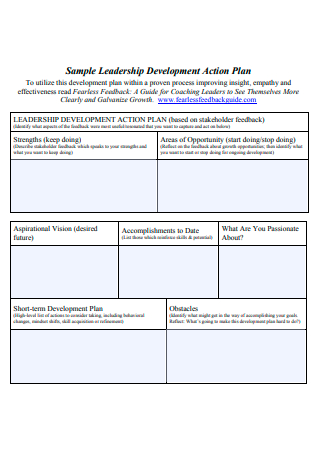
Sample Leadership Development Action Plan
download now -
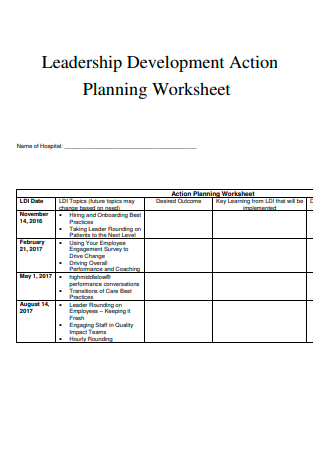
Leadership Development Action Planning Worksheet
download now -
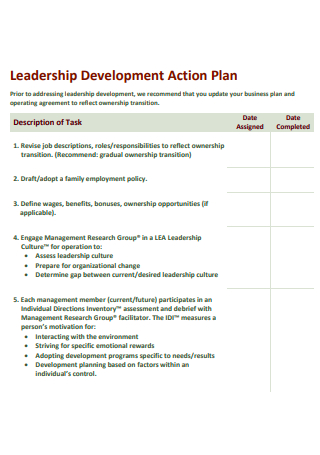
Printable Leadership Development Action Plan
download now -
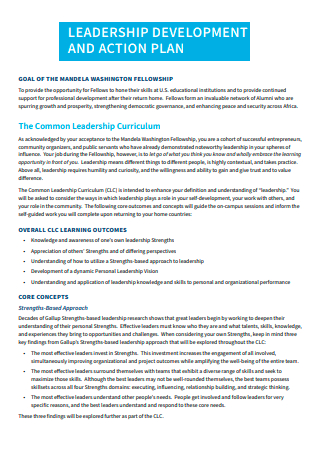
Simple Leadership Development Action Plan
download now -
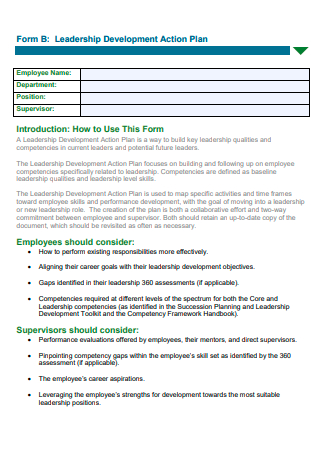
Leadership Development Action Plan in PDF
download now
FREE Leadership Development Action Plan s to Download
5+ Sample Leadership Development Action Plan
What Is a Leadership Development Action Plan?
Benefits of Great Leadership Development Training
Tips In Writing a Leadership Development Plan
How To Create a Leadership Action Plan
FAQs
What is a development goal example?
What are the 5 phases of leadership development?
What is learning and leadership development?
How do leaders motivate others?
What Is a Leadership Development Action Plan?
Every company must plan for all its employees to improve their leadership skills. A team leadership development plan gives employees at a company a complete plan for their professional growth. It has specific goals, objectives, and learning activities that help leaders get better at being leaders. The project aims to bring leaders ready to take on significant challenges and more responsibility. There are different levels of training for employees to ensure they learn good leadership skills and understand what it means to be a leader. Only 10% of people are naturally good leaders. Another 20% have some basic managerial skills that can be developed into good leadership.
Benefits of Great Leadership Development Training
There are numerous benefits to receiving superior leadership development training. Although the execution of a leadership development plan might result in many unintended benefits, a leadership development plan checklist reveals the following traits to be the most beneficial:
Tips In Writing a Leadership Development Plan
A leadership development plan is a comprehensive outline of the professional development and learning activities you will engage in over a specific time. Its purpose is to enhance your leadership skills. Your leadership-development strategy must be well-written, requiring time, systematic thought, and teamwork. For actual transformation, only a well-thought-out plan will be effective. If it is appropriately written and kept in an area where you will see it frequently, you will be more inspired to use it. You will discover a straightforward procedure for creating a leadership-development plan below.
1. Record Your Initial Development Objectives
Write down your reasoning for creating a leadership-development strategy. You may write a design from the beginning of your leadership career to prepare for higher-level positions. In the middle of one’s career, one’s plan can lead to enhanced abilities and expanded networks. Suppose you have reached the highest level of management. In that case, a leadership development program can help you continue to perform at your highest level, driving innovation and identifying the best prospects for the organization. Alternatively, you may be drafting this plan to catch up with the most recent leadership trends, train with the most advanced technologies, or address a known performance issue. Regardless of where you are in your career, a leadership-development plan can help you acquire the skills you need to overcome the challenges you face. Understand that everything you write in this step is subject to change, as you will learn more about yourself as you complete the subsequent steps.
2. Examine the Qualities of Great Leaders
The following phase in developing a leadership-development strategy is to draw inspiration from the characteristics and qualities of exceptional leaders. Due to the availability of biographies and other data, it is possible to identify the leadership attributes that have been continuously respected and influential throughout human history. Create a list of your preferred great leaders. Then, list the primary leadership skills exhibited by each individual. Finally, collect these leaders’ abilities, qualities, and competencies into a single list. This final list represents the type of leader you aspire to become. At this point, qualities and talents like honesty, communication, vision, and creativity may appear somewhat abstract; but subsequent steps will help you formulate realistic goals to develop them.
3. Evaluate Your Personality and Characteristics
This step necessitates using external resources to determine your personality, strengths, and temperament. You can utilize a different personality instrument, a 360-degree evaluation, an emotional-intelligence indicator, or any practical examination for your needs and objectives. Even though personality evaluations may appear imprecise, this stage is essential. You can customize your growth plan based on your natural temperament and answers to these questions. It can help you create a strategy that you’re genuinely interested in, which can be the deciding factor between a plan you utilize and one you don’t.
4. List Your Most Important Values
Your top values are another element of your unique leadership style that must be documented. This is significant because people with different values define leadership qualities in slightly different ways. In addition, your values dictate how you will manifest these characteristics and the objectives you will pursue. Your core beliefs govern all of your decisions, and it is pretty tough to alter them. If you are aware of your values, you will have a better idea of creating an effective plan that will remain highly relevant for you throughout time.
5. Compare self-perception to others’
After completing your self-evaluation, you may believe you have uncovered a fundamental truth (and this may be true). However, it is essential to solicit the opinions of those who know you well. Communicate with a few of your most reliable family members, friends, and peers. Request that they list the essential words that they believe best define your routine behaviors and skills. Next, do everything possible to discover what your coworkers say about you while you’re not around. You may require this information from a reliable peer.
6. Create an Individual Vision Statement
Create a personal vision statement by combining your ideas from the preceding processes. This statement will summarize everything you’ve learned about yourself and will serve as a reminder of your purpose. A personal vision statement may be limited to your occupation or represent a broader objective. You can revise your vision statement at any time! You only need your constitution to remind you of the path you wish to take today. If it ceases to inspire you, you can alter it.
7. Select Abilities to Develop
Once you have a personal vision statement that communicates your values, personality, and desired direction, you are prepared to concentrate on developing the specific leadership abilities you require. Create a list of the skills you currently possess. These competencies can be classified as technical, leadership, personal, and interpersonal. Take your time and list as many abilities as you choose. Having an up-to-date resume can be advantageous. Next, examine your list and identify which abilities are your specific strengths and which require improvement. You can compare your perceptions of your strengths and flaws to the judgments of reputable peers and mentors. Compare this list to your list of characteristics of excellent leaders. Would any of the talents identified as areas for development provide an opportunity to cultivate these characteristics? Would any of these development areas correspond to the deficiencies that others perceive you to have? Select just a few skills you wish to acquire or enhance. These talents must align with your values and goals. If a skill does not serve your vision but, for example, makes you look nice to others, you should probably not choose it.
How To Create a Leadership Action Plan
A leadership action plan is essential for identifying your strengths and weaknesses so that you may set improvement objectives and take steps to become a more robust and more effective leader. Your leadership action plan is essentially an analytical way of outlining how you will build the abilities required to assume higher-level jobs at work and grow in your career. The steps below give a framework for developing your leadership action plan, which you can use to drive your journey towards becoming a highly effective leader:
1. Evaluate your advantages and disadvantages
Make a list of your perceived leadership strengths and flaws. For example, influential leaders may be able to motivate others and assist with complex team tasks. Therefore, they may include delegating and motivation on a list of their professional skills. A professional weakness can consist of areas of your skill development that you wish to enhance, expand, or perhaps acquire for the first time. For instance, your firm may need a graduate degree for a specific position you want to rise to, but you have not yet obtained one. In this particular instance, your lack of credentials is a professional shortcoming. Your list of leadership shortcomings can serve as an ideal beginning point for your action plan, as these are the areas in which you should concentrate your professional development.
2. Create a mission and establish objectives.
Using your list of professional strengths and shortcomings, establish one or two goals to develop your poorest leadership qualities. Consider your leadership mission as well. For example, suppose one of your goals is to obtain a higher degree or certificate to expand your leadership chances. In that case, you should construct a mission statement explaining why others want to follow you once you’ve accomplished your goals.
3. Establish a timeline with quantifiable actions
Break each goal down into smaller steps. Then, plan how long it will take to reach each goal. For example, suppose one of your leadership goals is to become more inspiring and influential in larger teams. In that case, you could break this goal down into short-term goals like finishing a six-week course on leadership development and going to leadership training by a specific date. Setting a timeline for your purposes can help you stay motivated to reach meaningful goals that will help you grow as a leader.
4. Follow and assess your progress
Plan to measure your development regularly so you can monitor your progress towards your short-term and long-term professional objectives. Regular self-evaluations enable you to see where you need to make changes to your leadership action plan, such as rearranging your schedule, implementing new development tactics, or altering your strategies for attaining your goals. Write some notes regarding your development, in which you can analyze the areas in which you are making progress and the skill sets you may still need to hone.
5. Modify your action plan as required
Remain adaptable and receptive to change if you find roadblocks during your leadership development. To better lead your development team, you may like to attend a brief course on emerging software development concepts. The system is, however, filled for the following two terms. Consequently, you may need to modify your timeframe to account for the delay in attaining this short-term goal.
FAQs
What is a development goal example?
Improve your professional relationships and your networking skills. Improve how you use your time at work and how productive you are. Get a new degree or certification. Grow your professional network by attending more networking events.
What are the 5 phases of leadership development?
This book presents an overview of the leadership life cycle from a distinctively Christian perspective. It is structured around five leadership stages: creating trust, cultivating leaders, discerning vision, implementing plans, and transitioning out.
What is learning and leadership development?
Leadership training and development assists in the identification of high-potential persons who are likely to assume leadership roles and enhances the skills and knowledge of those who already hold leadership positions. Leaders may require soft and hard skills training depending on your firm’s issues.
How do leaders motivate others?
One of the best methods to encourage and drive your employees to work harder is to provide praise and awards. When one is commended in front of others, it pushes them to work more or perform better while simultaneously inspiring the others to work hard to be praised.
Good followers make good leaders. Leaders cannot effectively manage their constituents if they do not adhere to established rules. To become a successful leader, one must set a good example and implement a plan. Are you prepared to develop your very own Leadership Development Action Plan? Check out some of our available samples for your guide!
